from STRATFOR
-- this post authored by Omar Lamrani
 Space is becoming more congested, contested and competitive. Since the Soviet Union put the first satellite, Sputnik I, into space in 1957, no nation has deliberately destroyed another's satellite in orbit. But there is a growing possibility that battles may soon be waged in space.
Space is becoming more congested, contested and competitive. Since the Soviet Union put the first satellite, Sputnik I, into space in 1957, no nation has deliberately destroyed another's satellite in orbit. But there is a growing possibility that battles may soon be waged in space.
Although the militarization of space started long ago, a number of technological developments and tests over the past decade show that the race toward itsweaponization is accelerating. Driven by Washington's dominance of and strategic dependence on space, U.S. rivals are working to develop and deploy anti-satellite weapons (widely known as ASATs). The technology, which began to be developed during the Cold War, has become an area of intense competition for the world's most capable militaries over the past decade.

For the United States, being the leader in military space technologies provides immense advantages. At the same time, its outsize reliance on those technologies entails risks. The current unequal dependence on space, the United States fears, could give adversaries incentive to attack its infrastructure in orbit. Washington is therefore pushing to bolster its capabilities and is preparing for the possibility that a future conflict could escalate into space. As the militarized space race continues, the United States will stay focused on deterrence. A war in space would be devastating to all, and preventing it, rather than finding ways to fight it, will likely remain the goal.
An Unequal Dependence
















